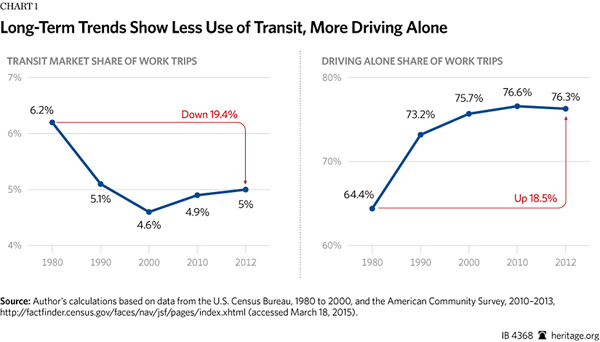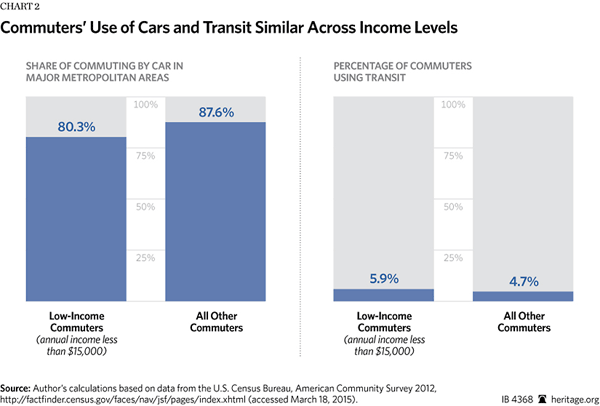More than three decades ago, federal legislation was enacted to transfer money from highway user fees to mass transit, such as subways and buses. The diversion is so substantial that each passenger mile of transit is supported by highway user fees (such as gasoline taxes) at a rate 15 times that of each roadway passenger mile.[1]
The rationale for federal transit funding includes assumptions that transit is better for the environment, is crucial to the mobility of low-income citizens, and reduces traffic congestion. This article examines these rationales.
The rationale for public subsidies to transit was to keep fares affordable for low-income citizens who did not have cars, as well as to reduce traffic congestion and, finally, to improve the environment. In the late 1970s, there were expectations among some in transit that reducing air pollution (smog) would require large numbers of drivers switching to transit. In fact, car travel continued to increase, while smog was reduced significantly anyway.[2]
Driving More
Transit’s share of urban travel has declined in the three decades since drivers started paying a tax on gasoline to support transit. From 1980 to 2012, transit’s share of work trips dropped by nearly 20 percent, while driving alone has increased by nearly 20 percent.
Work trips are particularly important, because their concentration during morning and evening peak periods are the proximate cause of most traffic congestion.
Transit’s all-day share of urban travel has fallen by 30 percent since 1982, despite the many new federally funded urban rail systems.[3] While higher gasoline prices have been associated with a modest increase in transit ridership, nine times as many people have started driving alone as taking transit to work since 2000.[4] Pure and simple, drivers have not abandoned their cars for transit. Moreover, the number of people working at home is on track to equal that of people taking transit by 2020—and without subsidies.
Even so, transit performs admirably in some markets. Between 40 percent and 80 percent of commuters use transit to the central business districts (downtowns) of New York, Chicago, Philadelphia, San Francisco, Boston, and Washington.[5] Moreover, these six municipalities (not the corresponding metropolitan areas) account for 55 percent of all transit commuting destinations, nearly 10 times their 6 percent share of national jobs.[6]
Outside these municipalities, where 94 percent of the jobs are located, only 2.4 percent of commuters use transit. This is because U.S. metropolitan areas are functionally 86 percent auto-oriented suburban.[7] These areas do not have a sufficient geographical concentration of employment to make high levels of transit service practical.
Rising Costs
Even as transit’s market share has been falling, overall ridership has risen due to a large increase in overall urban travel. But higher ridership has come at a substantial cost. Transit’s 1982 ridership base required total public expenditures of approximately $0.70 per passenger mile[8] (2011 dollars). The expenditure per additional rider has been much higher, at approximately $2.05 per passenger mile (2011 dollars). That is because transit service is provided to the markets with the highest concentration of destinations (work and otherwise), and as it is expanded to markets with less demand, higher expenditures are necessary. Any additional gains in transit ridership are likely to be at least as costly.
Moreover, transit expenditures are far higher per passenger mile than those of cars (including SUVs). Consumer expenditures for purchasing and leasing cars, operating costs, and highway user fees, as well as an adjustment to include government road expenditures in excess of highway user fees were approximately $0.26 per passenger mile in 2011.[9] By contrast, overall transit expenditures per passenger mile were more than four times as high, at $1.10.
Traffic Congestion
Meanwhile, transit has not reduced traffic congestion. Urban traffic congestion in the 52 metropolitan areas with populations of over 1 million people has increased by 150 percent since 1982, according to Texas Transportation Institute data. This is to be expected, because road capacity has not kept up with the increase in driving. However, metropolitan areas that have added more highway capacity have been rewarded. An example is fast-growing Houston, which had the nation’s worst traffic congestion in the mid-1980s, and has improved its position to eighth-most-congested city in the U.S. Phoenix has had similar success.
Low-Income Commuting
Given that a principal purpose of subsidizing transit has been to provide mobility to low-income commuters, it may be surprising that those with lower incomes rely on cars almost to the same extent as everyone else. The 2012 American Community Survey indicates that 80.3 percent of low-income commuters (below $15,000 annual income) drove cars. This is nearly as high as the 87.6 percent among commuters with incomes of $15,000 and above.
Only 5.9 percent of low-income commuters take transit, not much more than the 4.7 percent of those with higher incomes. The reality is that, without a car, the overwhelming majority of commuters, low-income and higher-income alike, are stranded with inferior employment opportunities, since they can access so few of the jobs in the metropolitan area by transit, walking, or cycling. Recent Urban Institute research suggested that “enhancing car access will notably improve the likelihood of employment among very low income adults, but investments in transit in areas with concentrated poverty will only have, at best, marginal effects.”[10]
Transportation and the Economy
Economic research shows that metropolitan areas perform better in economic growth and job creation if they have better mobility—measured in the percentage of jobs that can be reached in a certain amount of time (such as the national average of 25 minutes, one-way).[11] Today’s large metropolitan areas were made possible, at least in part, by the far greater access to jobs that only cars can provide. Brookings Institution research[12] indicates that the average commuter can reach only 6 percent of jobs in 45 minutes by transit in the larger metropolitan areas.[13] By comparison, car commuters can reach more than 10 times as many jobs in less time. David Levinson at the University of Minnesota has shown that the average employee can reach more than 80 percent of major-metropolitan-area (over 1 million population) jobs in 30 minutes or fewer traveling by car.[14] In short, auto-access jobs are more than 10 times as great, in two-thirds the time. It would be virtually impossible for transit to be expanded enough to equal this access.[15]
The average commute by car is approximately twice as fast as by transit. Indeed, the higher U.S. reliance on cars results in generally shorter work-trip travel times than is the case for international competitors and contributes to its domination of international gross domestic product per capita rankings.[16] Nine of the 10 richest metropolitan areas in the world are in the United States.[17]
Refocusing Federal Policy
Drivers have not shifted to transit, despite billions in federal transit funding and the many new rail lines. With transit commuting concentrated in just six municipalities, transit is not a genuinely federal issue. Public funding for transit would be more appropriately provided by the states and localities, where it is most important.
People need to be quickly connected with the larger metropolitan-wide job markets, a task that is beyond that of transit. Washington should limit its role to oversight and allow states and localities to invest in the roadway infrastructure that carries almost 99 percent of personal travel and 100 percent of highway freight volume.
—Wendell Cox is a visiting fellow at The Heritage Foundation, and principal of Demographia, a St. Louis-based public policy firm. He was appointed to three terms on the Los Angeles County Transportation Commission and chaired two American Public Transit Association (APTA) national committees.



